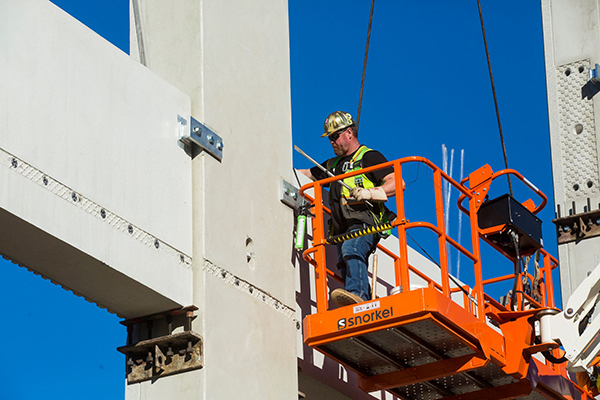 Parking Structure V is under construction on the north end of campus and is scheduled to open in Spring 2018. (Sacramento State/Jessica Vernone) More photos
Parking Structure V is under construction on the north end of campus and is scheduled to open in Spring 2018. (Sacramento State/Jessica Vernone) More photosSacramento State student Jasneet Sohal is spending more time than usual on her phone each morning. The kinesiology major is not on social media or reading emails, she’s looking for a place to park.
Sohal is consulting the Sac State Mobile app that provides fast access to where and how many spots are open in parking structures, surface lots and temporary parking designations.
In a season when places to put your ride come at a premium, the app is just one of the ways the university is preparing for future trends in transportation and parking.
“I have a daily commute from Elk Grove, and the app is helpful in that on my way here whenever I’m stuck in traffic or at a stoplight, I quickly refresh the app the see where I need to head to save time,” Sohal says. “So, if a parking garage is at full capacity, I know to steer clear and go where there are available parking spots.”
The app is proving especially helpful this fall as students and faculty face a shortage of on-campus parking caused by the univeersity's building boom. Construction projects underway include the new Science Complex, a Welcome Center and Parking Structure V, and a renovated University Union.
Tony Lucas, senior director for University Transportation and Park (UTAPS), says temporary parking lots developed in anticipation of construction have helped reduce parking pressure and ease campus congestion. One of these, the Ramona Lot off of Power Inn Road, is provding needed parking space and successfully diverting hundreds of vehicles away from campus every day.
“We were very aggressive in our marketing of the Ramona Lot,” Lucas says. “All new students to the campus were given a presentation during their orientation. We had five minutes with all freshman and all transfers and explained to them the severity of the parking issue on campus. We made the permits available to them and, so far, have sold more than 750 of the 900 available permits.”
Another combined 200 temporary parking spaces are across from Capital Public Radio and at McAuliffe baseball fields off State University Drive.
In February, an environmentally friendly Parking Structure V will be open across from Sacramento Hall. It will include 1,750 faculty/staff, student and residential hall spaces and feature a tire-filling station, 50 electric vehicle charging stations, green vehicle spaces and a high-tech parking guidance system.
“Providing parking for single occupant vehicles, however, is just one element of the transportation cycle,” Lucas says. “We are used to getting in the car by ourselves and driving to the campus by ourselves, and that is not a sustainable model.
"We can’t realistically grow our campus if everyone keeps doing that. So increasingly, we are working on alternative transportation.”
Lucas outlines transportation options that reduce commuters’ carbon footprint and also save time and money:
Bicycles: Since 2013, Sac State has invested more than $1 million to improve bicycle infrastructure and encourage cycling to campus. Enhancements include additional bike racks, compounds and lanes. Three free bicycle compounds serve the campus, adjacent to Guy West Bridge, north of Benicia Hall and at the corner of Sinclair Road andMoraga Way. They can be located on the UTAPS page of ther Sac State website.
Commuter Sleeve: For a steep discount, Sac State students, faculty and staff may ride all Sacramento Regional Transit (RT) fixed-route transit services, including light rail. Students pay $21/semester; employees pay $40/semester. Information is on the Sac State website.
Hornet Express Shuttle: This is a free campus transit system for students, faculty and staff with a valid Sacramento State OneCard. The shuttle operates Monday-Friday during the Fall and Spring semesters.
Zimride: This ride-sharing service is coming soon for students, faculty and staff. Users will register online or via the Sac State Mobile app with a valid Sacramento State email address to match with other registered users who have a similar commute schedule and route.
“This is a good time for our campus community to really evaluate our choices of how we get to campus,” says Lucas, who bikes to work several times per month. “Is jumping in your vehicle every day by yourself the best thing to do for the environment, and is it the best for our community?”
Lucas encourages commuters to "think green" and try a new way to get to campus this semester. Now is the time, he adds, to change our mindset when it comes to creating a sustainable campus and society now and for the future. - Anita Fitzhugh
